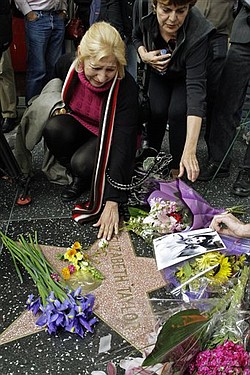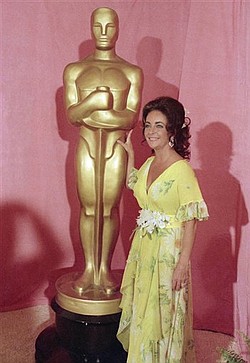A Hollywood jewel
AP
A woman reaches down to touch Elizabeth Taylor's star on the Hollywood Walk of Fame in Los Angeles Wednesday, March 23, 2011. Taylor died early Wednesday of congestive heart failure at the age of 79.
AP
This April 2, 1974 file photo shows actress Elizabeth Taylor standing by a statue of the Academy Award Oscar in Los Angeles. Elizabeth Taylor had it all: the violet, almond-shaped eyes, the creamy skin, the pouty lips and raven hair. Of course, there were her Oscars, iconic roles and many husbands, too, but Taylor is indeed most renowned for her beauty. She died Wednesday at age 79 of congestive heart failure.
Actress was template for modern celebrities
Associated Press
LOS ANGELES
Elizabeth Taylor, the violet-eyed film goddess whose sultry screen persona, stormy personal life and enduring fame and glamour made her one of the last of the classic-movie stars and a template for the modern celebrity, died Wednesday at age 79.
She was surrounded by her four children when she died of congestive heart failure at Cedars-Sinai Medical Center, where she had been hospitalized for about six weeks, said publicist Sally Morrison.
“My mother was an extraordinary woman who lived life to the fullest, with great passion, humor and love,” her son, Michael Wilding, said in a statement.
“We have just lost a Hollywood giant,” said longtime friend Elton John. “More importantly, we have lost an incredible human being.”
Taylor was the most blessed and cursed of actresses, the toughest and the most vulnerable. She had extraordinary grace, wealth and voluptuous beauty, and won three Academy Awards, including a special one for her humanitarian work. She was the most loyal of friends and a defender of gays in Hollywood when AIDS was new to the industry and beyond. But she was afflicted by ill health, failed romances (eight marriages, seven husbands) and personal tragedy.
“I think I’m becoming fatalistic,” she said in 1989. “Too much has happened in my life for me not to be fatalistic.”
Her more than 50 movies included unforgettable portraits of innocence and of decadence, from the children’s classic “National Velvet” and the sentimental family comedy “Father of the Bride” to Oscar-winning transgressions in “Who’s Afraid of Virginia Woolf?” and “Butterfield 8.” The historical epic “Cleopatra” is among Hollywood’s greatest on-screen fiascos and a landmark of off-screen monkey business, the meeting ground of Taylor and Richard Burton, the “Brangelina” of their day.
She played enough bawdy women on film for critic Pauline Kael to deem her “Chaucerian Beverly Hills.”
But her defining role, one that lasted past her moviemaking days, was “Elizabeth Taylor,” ever marrying and divorcing, in and out of hospitals, gaining and losing weight, standing by Michael Jackson, Rock Hudson and other troubled friends, acquiring a jewelry collection that seemed to rival Tiffany’s.
She was a child star who grew up and aged before an adoring, appalled and fascinated public. She arrived in Hollywood when the studio system tightly controlled an actor’s life and image, had more marriages than any publicist could explain away and carried on until she no longer required explanation. She was the industry’s great survivor, and among the first to reach that special category of celebrity — famous for being famous.
She was a star at age 12, a bride and a divorcee at 18, a superstar at 19 and a widow at 26. She was a screen sweetheart and martyr later reviled for stealing Eddie Fisher from Debbie Reynolds, then for dumping Fisher to bed Burton, a relationship of epic passion and turbulence, lasting through two marriages and countless attempted reconciliations.
Taylor’s ailments wore down the grudges. She underwent at least 20 major operations and nearly died from a bout with pneumonia in 1990. In 1994 and 1995, she had both hip joints replaced, and in February 1997, she underwent surgery to remove a benign brain tumor. In 1983, she acknowledged a 35-year addiction to sleeping pills and pain killers and went into rehab.
The dark-haired Taylor made an unforgettable impression in Hollywood with “National Velvet,” the 1945 film in which the 12-year-old belle rode a steeplechase horse to victory in the Grand National. She matured into a ravishing beauty in “Father of the Bride” in 1950 and into a respected performer and femme fatale the following year in “A Place in the Sun.”
“I don’t entirely approve of some of the things I have done, or am, or have been. But I’m me. God knows, I’m me,” Taylor said around the time she turned 50.
 43
43


